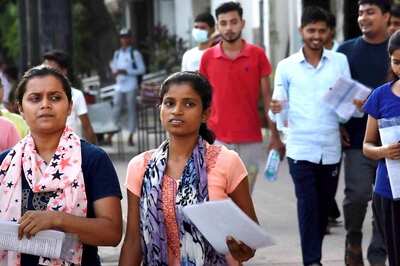
views
New Delhi: As the Bird Flu scare spreads far and wide, the most important tool to tackle it is knowledge about the disease so that one does not fall victim to the usual myths associated with the disease.
Here is a lowdown on the Bird Flu and the risk it poses to human beings.
First the signs and symptoms of bird flu in humans
Bird flu is very similar to other influenza viruses. Initial symptoms are :
- Fever
- Muscle weakness and/or pain
- Sore throat and cough
- Sore eyes (conjunctivitis) is seen in some patients
Causes of death and complications are:
- Severe viral pneumonia
- Respiratory distress syndrome
- Multi-organ failure
Since there are so many cases of influenza, pneumonia or any other respiratory illness, when does one suspect that the patient is a case of bird flu?
One suspects that a patient with influenza or pneumonia or any other respiratory illness is a case of bird flu avian influenza if the patient has had direct or indirect contact through handling or having taken care or getting near sick chickens or other birds.
A laboratory confirmation of the bird flu infection and epidemiologic link with unusual death or epidemics of chickens will support the diagnosis of bird flu.
What is the treatment of bird flu?
Treatment for H5N1 infection is essentially the same as for other influenza viruses. Antiviral drugs, some of which can be used for both treatment and prevention, are clinically effective against influenza A virus strains in otherwise healthy adults and children, but have some limitations. Some of these drugs are also expensive and supplies are limited.
Is there a vaccine against bird flu?
No. The vaccine currently available against the circulating strains in humans will not protect from the disease caused by H5N1. However, it is recommended for individuals who are potentially exposed to bird flu like poultry handlers, workers and breeders to prevent recombination of avian with the human influenza virus.
How do we prevent bird flu?
The ban on importation of live chickens and other poultry products from countries affected with bird flu is a critical step to prevent the entry of bird flu into the country.
For poultry caretakers and handlers of chickens and other birds:
- Avoid contact of poultry with wild birds, in particular waterfowl
- Control human traffic into poultries
- Practice proper hand washing and cleaning and disinfection procedures in poultries
- Report to authorities any unusual death or illness of chickens and other birds
- Report to authorities any illness among the workers in poultry farms
For the general public:
- Thoroughly wash hands with soap and water before and after handling chicken meat
- Clean kitchen surfaces and utensils before and after use
- Cook chicken well by seeing to it that the boiling temperature is reached
- Do not sell live chickens in the market while there is a threat of bird flu.
- Do not let chickens roam freely. Keep them in cages or pens.
- Do not place chickens, ducks and pigs together in one area, cage or pen.
- Do not catch, get near or keep in captivity wild birds.
- Report to authorities any unusual death or illness of chickens and other birds
- Report to authorities any case of respiratory illness with history of exposure to sick or dead chickens and other birds
What type of personal protective equipment (PPE) is recommended for those who are involved with disease control and eradication activities?
- According to WHO, US NIOSH certified N-95, European CE certified EN143 P2 / EN149 FFP2, or comparable national/regional particulate respirators should be worn by workers who eradicate infected poultry.
- Higher level particulate respirators may also be used.
- Disposable gloves, protective clothing, shoe covers or boots, and safety goggles should also be worn by eradication workers.
- Disposable PPE should be properly discarded, and non-disposable PPE should be cleaned and disinfected. Hand hygiene measures should be performed after removal of PPE.
















Comments
0 comment